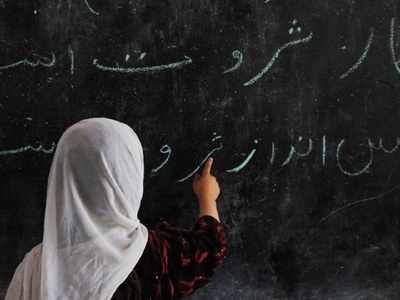- News
- India News
- Literacy rate for Muslims worse than SC/STs
Trending
This story is from August 13, 2020
Literacy rate for Muslims worse than SC/STs
The report shows that among the various social groups, the literacy rate for those aged 7 yrs or more was the highest for “others”, which is non-SC/ST/OBC population groups, at 91% for men and 81% for women. This proportion declines to 84% for OBC men and 69% for OBC women. For SCs, the ratio was 80.3% for men and 64% for women and for STs 78% for men and 61% for women.

Representative photo: AFP
NEW DELHI: A decade and a half after the Sachar Committee highlighted the issue, a report from the National Statistical Office reveals that Muslims are on various yardsticks of academic marginalisation as bad or even worse than SCs and STs.
The report shows that among the various social groups, the literacy rate for those aged 7 yrs or more was the highest for “others”, which is non-SC/ST/OBC population groups, at 91% for men and 81% for women.This proportion declines to 84% for OBC men and 69% for OBC women. For SCs, the ratio was 80.3% for men and 64% for women and for STs 78% for men and 61% for women.
Among religious groups, 88% of Christian men and 82% of women were literate, the highest proportions for both genders. This was followed by Sikhs and Hindus. The literacy rate of 80.6% among Muslim men was equivalent to that for Dalits and marginally higher than the rate among tribals. The literacy rate for Muslim women was higher than Dalit or tribal women, but lower than for women of any other religious group.


At the primary level, the GAR of 100 for Muslims was lower than “others”, SCs, STs, OBCs, Sikhs, Christians, and Hindus. At the upper primary level, Muslims were the only community whose GAR was below 90%. At the secondary level, the GAR of 71.9% for Muslims was lower than STs (79.8%), SCs and OBCs. Similarly at the higher secondary level, the GAR was lowest for Muslims at 48.3%, well below even the 52.8% for Dalits.
Above the higher secondary level, the GAR of 14.5% for Muslims was just above 14.4% for tribals but below 17.8% for Dalits. Unlike the tribal population, of which a significant proportion lives in remote areas, Muslims typically don’t live very far from higher educational institutes and yet the drop out at this level was nearly equal.
Muslims also had the highest proportion of youth (age 3-35 yrs) who had never enrolled in formal educational programmes. About 17% of Muslim men in this age group had never been enrolled for education. This was higher than for SCs (13.4%) and STs (14.7%). Similarly, for Muslim females, this ratio was 21.9% comparable with ST females, of whom 22.4% in the age group of 3-35 yrs reported having never enrolled in any academic programme
The report shows that among the various social groups, the literacy rate for those aged 7 yrs or more was the highest for “others”, which is non-SC/ST/OBC population groups, at 91% for men and 81% for women.This proportion declines to 84% for OBC men and 69% for OBC women. For SCs, the ratio was 80.3% for men and 64% for women and for STs 78% for men and 61% for women.
Among religious groups, 88% of Christian men and 82% of women were literate, the highest proportions for both genders. This was followed by Sikhs and Hindus. The literacy rate of 80.6% among Muslim men was equivalent to that for Dalits and marginally higher than the rate among tribals. The literacy rate for Muslim women was higher than Dalit or tribal women, but lower than for women of any other religious group.

The gross attendance ratio (people attending a level of education as a proportion of the population of the corresponding age group) was the lowest for Muslims among various social and religious groups at all levels of education except above higher secondary, where it was between the rates for Dalits and tribals.

At the primary level, the GAR of 100 for Muslims was lower than “others”, SCs, STs, OBCs, Sikhs, Christians, and Hindus. At the upper primary level, Muslims were the only community whose GAR was below 90%. At the secondary level, the GAR of 71.9% for Muslims was lower than STs (79.8%), SCs and OBCs. Similarly at the higher secondary level, the GAR was lowest for Muslims at 48.3%, well below even the 52.8% for Dalits.
Above the higher secondary level, the GAR of 14.5% for Muslims was just above 14.4% for tribals but below 17.8% for Dalits. Unlike the tribal population, of which a significant proportion lives in remote areas, Muslims typically don’t live very far from higher educational institutes and yet the drop out at this level was nearly equal.
Muslims also had the highest proportion of youth (age 3-35 yrs) who had never enrolled in formal educational programmes. About 17% of Muslim men in this age group had never been enrolled for education. This was higher than for SCs (13.4%) and STs (14.7%). Similarly, for Muslim females, this ratio was 21.9% comparable with ST females, of whom 22.4% in the age group of 3-35 yrs reported having never enrolled in any academic programme
End of Article
FOLLOW US ON SOCIAL MEDIA










